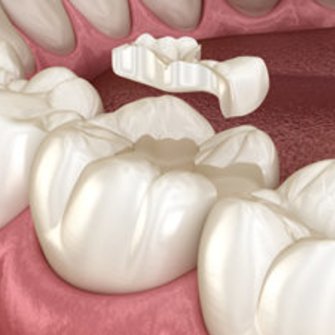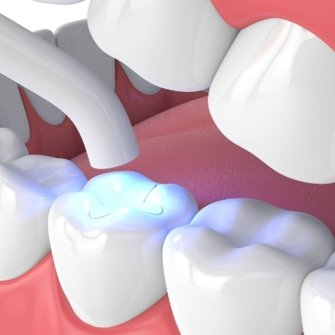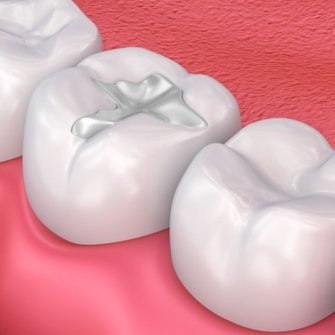
Tooth Fillings Overview
A tooth filling involves "filling" the cavity in a tooth caused by decay. The dentist must first remove all of the decay. The chosen material is then packed into the space within the tooth to protect it from pain, sensitivity and further decay.
Who is this for
- People with tooth decay.
- People with cracked or broken teeth.
- People with excessively worn teeth.
Treatment abroad
- Minimum stay: 1 Day
- Number of trips: 1
Treatment process
- Composite filling lasts 20 minutes to an hour.
- Ceramic filling needs 2 visits, each around 30 minutes
- Patients are usually free to go about their day immediately after treatment.
- Sensitivity might persist for a few days after a tooth filling.
Tooth Fillings Cost
Type
Advantages
Disadvantages
Price
Composite Tooth Filling
Same day
Price
Less durable
€60
Ceramic Filling
Durable
Treatment Time(2 visits)
Price
€200
Tooth Fillings Cost
Type
Price
Composite Tooth Filling
€60
Inlay/Onlay Ceramic Filling
€190
Tooth Filling Process
What is tooth filling?
A tooth filling involves "filling" the cavity in a tooth caused by decay. The dentist must first remove all of the decay. The chosen material is then packed into the space within the tooth to protect it from pain, sensitivity and further decay.
How does tooth filling work?
- Anaesthetic: As your dentist will be removing decay that could be close to the nerve in the tooth, a local anaesthetic is necessary. A couple of injections will probably be required, both directly into the gum surrounding the tooth.
- Decay removal: Once the area is numb, your doctor will begin the process of removing the dead and decayed matter from within your tooth. A range of different instruments is used to ensure every piece of decay is fully removed.
- Cleaning: Once all the decay has been removed, your dentist will clean the tooth to prepare for your filling. This step is essential as it prevents further decay and ensures the filling remains in place.
- Tooth filling: The filler material is applied gradually in layers. Each layer is treated with a special light which hardens it before the next one is applied. Once all of the layers are in place, your dentist will shape the filling to the desired shape. Excess filler is removed, and the filling is then smoothed.
- Extra process for ceramic fillings: Dentist will make a mould in the shape of the tooth using a special form of dental "putty". Impressions are also taken of the teeth opposite the one being filled, so that the dentist can ensure that the filling grinds smoothly against the opposing teeth. Labs receive the impression and create hard copies, usually out of plaster. This hard mould is then used to create ceramic filling, which is sent back to the dentist. The dentist now cements the filling in place, and may need to trim it slightly to handle any imperfections in the preparation process.
Are there different types of tooth filling?
There are 2 main types of filling in use today. Which one you're offered will depend on your dentist's preferences as well as your budget.
- Composite: Composite fillings are very popular these days as they can be manufactured to match the exact colour of your other teeth. Made with various resins and fillers such as glass and quartz, compositive fillers are highly durable and largely invisible. More and more people are opting for composite fillings, and with good reason. They can be coloured to blend in with existing teeth seamlessly. They are also known to bond chemically with teeth, giving them added strength and longevity. Also, composite fillers are more versatile than other options. They can be used to fill smaller, awkwardly-shaped cavities - so less preparation is required.
- Ceramic: A ceramic filling can be made to look just like the tooth it covers - but with the added advantage of being resistant to colour changes.
Temporary fillings: Temporary fillings are made with cheaper materials as they're usually only expected to last a week or two. They're used when people are waiting for permanent solutions. They're also used to fill the space in a tooth immediately after root canal treatment. And if you ever have emergency dental treatment, there's a chance you might be given a temporary filling until a more detailed procedure can be administered.
What should I expect?
Fillings are an everyday, routine job for dentists around the world. If everything goes to plan, don't expect to be in the dentist's chair for more than half an hour. Depending on the scale of the problem, you may be given more than one pain-killing injection. Just try to remain calm and still throughout the procedure. Your dentist might advise you to avoid temperature extremes for a day or two. You might feel a little residual pain, but other than that, there's not a lot to worry about.
TEETH FILLING GALLERY
Teeth filling process images
After Care
What is the post operative care for tooth filling?
- Your anesthesia will wear off in approximately 1-3 hours after the procedure. It is very important not to chew on the numb side (to prevent biting tongue, lip, etc.) until the anesthesia wears off.
- Children should be observed until the anesthesia has worn off. They may chew on the inside of their cheeks, lips and tongue which can cause serious damage.
What is the post-operative diet for tooth filling?
When a very large filling is placed, your dentist may ask that you wait until the next day to chew on your new filling and to use your opposite side to chew in the meantime.
Tooth Filling FAQ
Do dental fillings look natural?
Ceramic and composite filling are the same colour as tooth and give a natural appearance to the tooth.
After Care
What is the post operative care for tooth filling?
- Your anesthesia will wear off in approximately 1-3 hours after the procedure. It is very important not to chew on the numb side (to prevent biting tongue, lip, etc.) until the anesthesia wears off.
- Children should be observed until the anesthesia has worn off. They may chew on the inside of their cheeks, lips and tongue which can cause serious damage.
What is the post-operative diet for tooth filling?
When a very large filling is placed, your dentist may ask that you wait until the next day to chew on your new filling and to use your opposite side to chew in the meantime.
Tooth Filling FAQ
Do dental fillings look natural?
Ceramic and composite filling are the same colour as tooth and give a natural appearance to the tooth.
Plan your treatment and get a quote online.
30 minutes free online video and phone consultation. Schedule your virtual visit.









